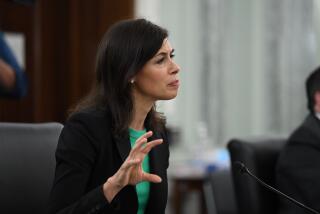FCC to propose nationwide expansion of high-speed Internet
- Share via
Reporting from Los Angeles and Washington — Declaring expansion of broadband Internet access the nation’s next great infrastructure challenge, federal regulators Monday unveiled an ambitious, decade-long project to make super high-speed connections available in every corner of the country.
The plan by the Federal Communications Commission sets a goal of making sure at least 100 million homes have affordable access to networks that allow downloading data from the Internet at speeds of at least 100 megabits per second -- at least 20 times faster than what most people get today. The proposal, which will be sent to Congress, also seeks to put ultra-fast Internet access of 1 gigabit per second in public facilities such as schools, hospitals and government buildings in every community.
The goal is to transform the nation’s Internet infrastructure and make high-speed access affordable to everyone, the FCC said. The agency proposes to use wireless connections as a cheaper and quicker alternative to laying wires or fiber optic cables to unserved areas. One of the plan’s main objectives, it said, is to make the United States home to “the fastest and most extensive wireless networks of any nation.”
The plan, which for the most part the FCC would implement, is expected to face opposition from broadcasters, who fear they would be forced to give up some of their airwaves. Telecommunications companies and some Republicans in Congress also are concerned about possible new regulations that, they warn, could stifle investment in expanding broadband networks.
Although the FCC made paper copies of the 356-page plan available to reporters Monday, it would not be released to the public until Tuesday. As such, interest groups and analysts were unable to comment on the details Monday. They stressed that those details were crucial.
Still, consumer and public interest groups praised the commission for taking on the challenge of spurring the expansion of affordable high-speed Internet after years of waiting for private companies to do it.
“It’s exciting that we have national attention on putting together a broadband plan after this issue had been dropped from the federal agenda for a number of years,” said Karen Mossberger, a professor of public administration at the University of Illinois at Chicago, who studies broadband availability in the U.S.
“To date, just leaving things up to the market has not produced affordable broadband,” she said, adding that Internet access is more expensive in the U.S. than in at least a dozen other countries.
Public safety
Another key component of the plan is creating a new wireless network for police, firefighters and other public safety workers so that during major emergencies they can communicate and share data and video between departments.
Lawmakers and public safety organizations have pushed for such a network since the Sept. 11, 2001, terrorist attacks, when first responders at the World Trade Center had trouble communicating.
In 2008, the FCC encouraged private companies to help build such a network by offering cheap access to public airwaves, but the effort failed.
The FCC has recommended that Congress authorize $12 billion to $16 billion to create the network. That would be the largest allocation of money under the broadband strategy.
There is no set price tag for the overall plan because Congress could decide to accelerate parts of it. FCC officials said the plan is designed to pay for itself through existing revenue streams, such as fees already charged to telecommunications companies to spread service to rural areas.
The FCC, which spent a year studying the issue, said the federal government needs to do more to make sure high-speed networks reach all Americans, allowing them to tap into the information economy and take advantage of future advancements such as electronic health records.
“The National Broadband Plan is a 21st century road map to spur economic growth and investment, create jobs, educate our children, protect our citizens and engage in our democracy,” FCC Chairman Julius Genachowski said. President Obama, who has made expanding Internet access a priority, appointed the former technology executive to the FCC post last year.
Airwaves in demand
Tapping into the wireless airwaves is a key part of the FCC’s plan. It wants to reallocate a huge chunk of radio-frequency spectrum to use for high-speed Internet service, regarded as a much cheaper and quicker way of spreading broadband service than laying fiber cables -- particularly in rural areas.
But that spectrum is assigned to TV and radio broadcasters, who are expected to strongly oppose any proposal to take it away, even if the FCC would share money with them from auctioning off the use of those airwaves to telecommunications companies.
FCC staff said it would be up to broadcasters to decide whether they wanted to give up some of their airwaves.
But the report said the FCC should explore alternatives, such as forcing some broadcasters to change how they transmit, if incentives don’t free up enough airwaves.
That wording raised alarm at the National Assn. of Broadcasters.
“We were pleased by initial indications from FCC members that any spectrum reallocation would be voluntary, and were therefore prepared to move forward in a constructive fashion on that basis,” Dennis Wharton, the group’s executive vice president of media relations, said in a statement. “However, we are concerned by reports . . . that suggest many aspects of the plan may in fact not be as voluntary as originally promised.”
Telecommunications industry trade group USTelecom, which represents companies including Verizon Communications Inc. and AT&T Inc., said it applauded the goals of the plan. It commended the FCC for what it perceived as the plan’s focus on lowering costs and expanding access through market competition, rather than regulation.
Getting connected
Access to high-speed Internet service has grown dramatically -- nearly 200 million Americans now have access, compared with 8 million in 2000, the FCC said.
But about 100 million U.S. homes are not hooked up to a high-speed network. Much of that is because of the price for service, but about 14 million Americans could not get access -- even if they could afford it -- because it is not available where they live.
Congress included $7.2 billion for grants to jump-start the expansion of high-speed Internet access in the $787-billion economic stimulus plan passed last year, and gave the FCC a year to develop a broader strategy. Consumer groups and Internet activists have complained for years that the U.S. had no real broadband strategy, a major reason that the country continues falling in international rankings for high-speed Internet access per capita. The U.S. was ranked 15th last year by the Organization for Economic Cooperation and Development. It was ranked fourth in 2001.
jim.puzzanghera@ latimes.com
More to Read
Sign up for Essential California
The most important California stories and recommendations in your inbox every morning.
You may occasionally receive promotional content from the Los Angeles Times.










